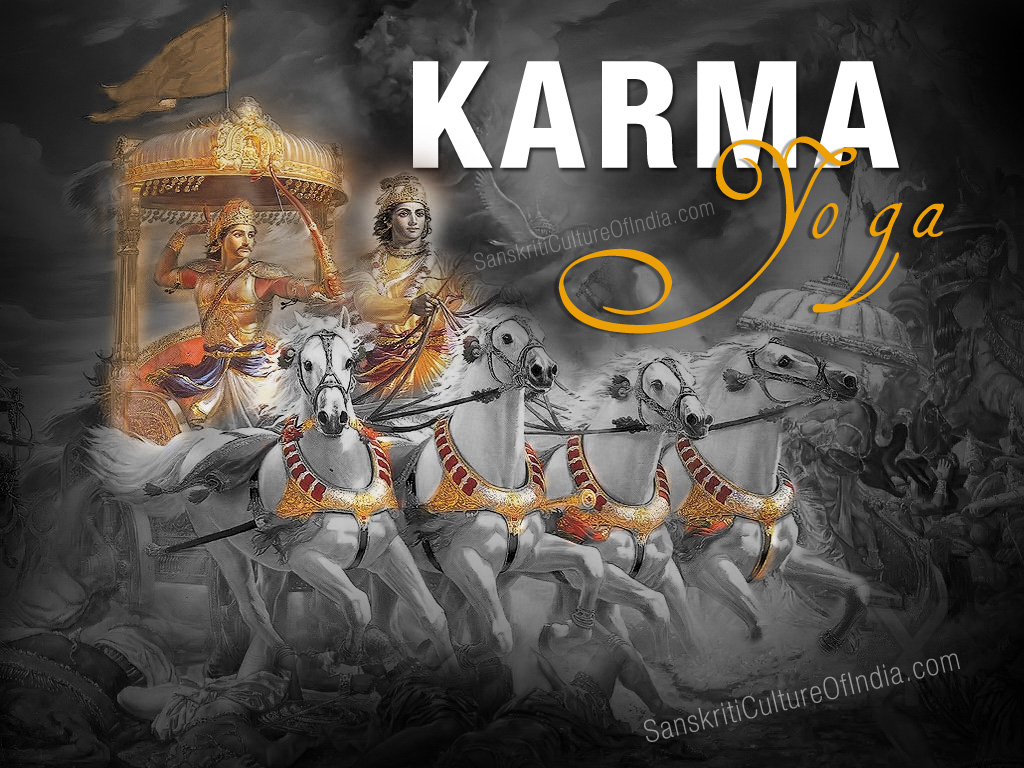Karma Yoga is Meditation in Action:
“Karma” means action and “yoga” means loving unity of our mind with God. To perform karma and also practice yoga means to remain engaged in activity in the world while remaining in a state of devotional unity with God. This is true spiritual action.
Your bhakti yoga meditation practice will combine all these aspects and it will include:
- Daily sitting meditation
- Daily dynamic meditation woven seamlessly into the fabric of your life’s activities
Before we look at guidelines for these, let’s explore how process is described in the Hindu scriptures.
 Karma Yoga of the Bhagavad Gita:
Karma Yoga of the Bhagavad Gita:
One of the most important scriptures of Hinduism, the Bhagavad Gita, was revealed under unusual circumstances: moments before a war and in the middle of a battlefield. It is comprised of a 700-verse dialogue between Lord Krishna, supreme God, and Arjuna, his loving disciple.
The all-in-one solution of the Bhagavad Gita for eliminating karma is Lord Krishna’s advice to practice akarma or actions that have no karmic consequence.
If we could perfect akarma in daily activity, the consequences of our actions would automatically be neutralized — even though we are engaged in action.
This means that from the point of view of karmic debt, no consequences would be added to our “account”. The only key to this is we must maintain an unbroken and continuous devotion to God.
Karma yoga philosophy in the Bhagavad Gita is summed up in one statement of Lord Krishna:
“Remember Me and fight.”
But is it really possible to simultaneously do devotional remembrance and be engaged in activity? Can the mind function in two places at the same time? This is definitely impossible, but for karma yoga to be done properly, both have to happen simultaneously.
For example, if you are at work and absorbed in a project, and remember God occasionally, how are both these actions accounted for as karmas?
The time you spent in devotional remembrance will be considered devotional action, and the time you spent engrossed in working will be considered normal action. This is not karma yoga.
Plus, a common misconception describes karma yoga as “performing action without being attached to the results”. Although this sounds noble, is it psychologically possible for any human being to do this?
The fact is because we are constantly trying to find authentic happiness, we will always anticipate the outcome of our actions in advance of doing them.
The practical form of the Gita’s karma yoga…
In the Gita, Krishna was both supreme God and Arjuna’s spiritual guide. Krishna advised Arjuna to surrender to Him and to simply follow His instructions. By transferring his motivation for action to a divine personality, Arjuna would not be responsible for the outcome of the actions he was instructed to perform.
For example, a police officer is issued a revolver, which he is instructed to use in the line of duty by his superiors. It could happen that he kills someone in the pursuit of law and order. In the eyes of the justice system, this will not be considered a crime. He did not use his own mental motivation to decide to kill someone — he simply followed the guidelines given to him by his superiors.
In Arjuna’s situation, in spite of engaging in war, all his actions were counted as devotion, because his heart, mind and body were fully dedicated to the will of Krishna.
This again highlights one of the most important points of karma yoga: The mind is the performer of action, not the physical body.
It is our personal motive that has to be carefully redirected for karmic consequences to change or be neutralized.
A Closer Look at the Spiritual Theory
If a practitioner is surrendered to a true divine Guru, and performs actions entrusted to him by his Guru, that activity is considered not only karma yoga, but also bhakti or spiritual action. It will be free of a karmic consequence. That practitioner is not directly attached to the results of that activity because his motive is to follow the instructions of his Guru.
Arjuna accepted Lord Krishn as his Guru at the very beginning of the Gita when he declared he was Lord Krishna’s disciple. He preserved the understanding during the entire Mahabharata War that he was doing service for his Guru.
In this way, just by holding this intention, his devotion remained unbroken and his actions were considered karma yoga. Thus, service to a true Guru is called karma yoga or devotion.
Practically speaking, a Guru will give instructions on how a practitioner can keep his mind engrossed in a state of continuous devotional remembrance. Simply by following these instructions, a disciple is automatically practicing karma yoga.
Those devotional guidelines take the form of (1) karma sanyas and (2) karma yoga.
Karma Sanyas – Quiet Time for Meditation
And old method of dyeing fabric in India was to place a cloth in a dye bath and then allow it to dry in the sun.
After drying, the intensity of the color faded. Again the cloth was placed in a dye bath, again it was placed in the sun, and again the color faded, but the second time more of the color remained.
After entering the dye bath multiple times, the color eventually became intense and fixed.
Similarly, to establish devotion in our hearts and minds, it is important to have a structured daily practice of sitting meditation.
The main elements of a daily devotional practice include:
- Heart-centered prayer
- Kirtan or chanting meditation combined with active visualization
- Aarti-the offering of light – a brief ceremony that reaffirms the spirit of our devotional dedication
Karma Yoga – Dynamic Devotion
For the attainment of divine love, the Vedas state that there is only one rule and one prohibition that apply to bhakti yoga meditation. The rule is: “Always remember Radha Krishna.” The prohibition is, “Never forget Radha Krishna.”
This means that after our sitting meditation, our meditation should continue — while eating, sleeping, walking, working, talking, resting, and so on.
Wherever you are, all the time, whatever you are doing, remember your divine beloved and don’t forget Him! This simultaneous devotion and action is karma yoga. This state of devotional consciousness is cultivated over time with practice.
For example, in the old days street musicians with hand organs kept small monkeys. A monkey by nature is extremely active. How to make a monkey’s nature conform to sitting still, and that, too, in a confined space?
The musician’s technique was to first restrain the monkey with a 100-foot rope. If the monkey tried to go outside of this range, he was stopped. He thought, “Okay, I’ll jump around in a 100-foot area.”
When he was tied with a 50-foot rope he thought, “I went 100 feet yesterday, today I’m restricted to this much.” So he jumped around in a 50-foot area.
When the monkey was finally limited to only 1 foot of rope, he sat quietly, “Why should I drive myself crazy? I’ll just sit here.”
The human mind has this same monkey-like nature. It roams far and wide. Our goal is not to tame it’s active nature, but to train it to roam in a particular area. This is done by gently tying it with the devotional rope of love.
In sitting meditation we cultivate a feeling a devotional relationship with God. In active meditation we can continue this in three ways:
- Embed your intention — Every person has a mission that guides his life’s activities. For example, very few people like to work, but they do it because their mission is to support themselves or their family. While they are at work, although this motive is hidden deep in their mind, it still guides their decisions and actions.Similarly, when we firmly understand the purpose of our life is God-realization, this intention deeply embeds itself in the mind. If cultivated properly, this subconscious devotional intention remains in all our activities, even when we are sleeping.
- Feel divine presence — in sitting meditation we visualize and feel our relationship to God’s personal form. In activity, take hourly breaks for 30 seconds or a minute and with open eyes sense the presence of your worshipped form of God or Radha Krishna. Simply feel you are not alone. Imagine them near or far, sitting, standing or in any position, in any mood of love.
- Share your awareness — After visualizing God’s presence, either feel He is watching you or that you are showing Him what you are doing.
- Avoid wrong association — your associations and environment will affect your feeling of divine connection. Be mindful and avoid those situations that divert your devotional intention.
There is no restriction of time, place and activity for this remembrance. It can be done anywhere, at any time. You do not need to sit in a particular position or have closed eyes. This very simple practice will recall the blissful feelings of your seated meditation and help to stabilize your devotional experience.
~Bhakti Yoga Meditation











